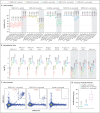Pan-Sarbecovirus Neutralizing Antibodies in BNT162b2-Immunized SARS-CoV-1 Survivors
- PMID: 34407341
- PMCID: PMC8422514
- DOI: 10.1056/NEJMoa2108453
Pan-Sarbecovirus Neutralizing Antibodies in BNT162b2-Immunized SARS-CoV-1 Survivors
Abstract
Emerging severe acute respiratory syndrome coronavirus 2 (SARS-CoV-2) variants of concern pose a challenge to the effectiveness of current vaccines. A vaccine that could prevent infection caused by known and future variants of concern as well as infection with pre-emergent sarbecoviruses (i.e., those with potential to cause disease in humans in the future) would be ideal. Here we provide data showing that potent cross-clade pan-sarbecovirus neutralizing antibodies are induced in survivors of severe acute respiratory syndrome coronavirus 1 (SARS-CoV-1) infection who have been immunized with the BNT162b2 messenger RNA (mRNA) vaccine. The antibodies are high-level and broad-spectrum, capable of neutralizing not only known variants of concern but also sarbecoviruses that have been identified in bats and pangolins and that have the potential to cause human infection. These findings show the feasibility of a pan-sarbecovirus vaccine strategy. (Funded by the Singapore National Research Foundation and National Medical Research Council.).
Copyright © 2021 Massachusetts Medical Society.
Figures

Comment in
-
Decades-old SARS virus infection triggers potent response to COVID vaccines.Nature. 2021 Aug;596(7873):471-472. doi: 10.1038/d41586-021-02260-9. Nature. 2021. PMID: 34408311 No abstract available.
References
Publication types
MeSH terms
Substances
Grants and funding
LinkOut - more resources
Full Text Sources
Other Literature Sources
Medical
Miscellaneous
